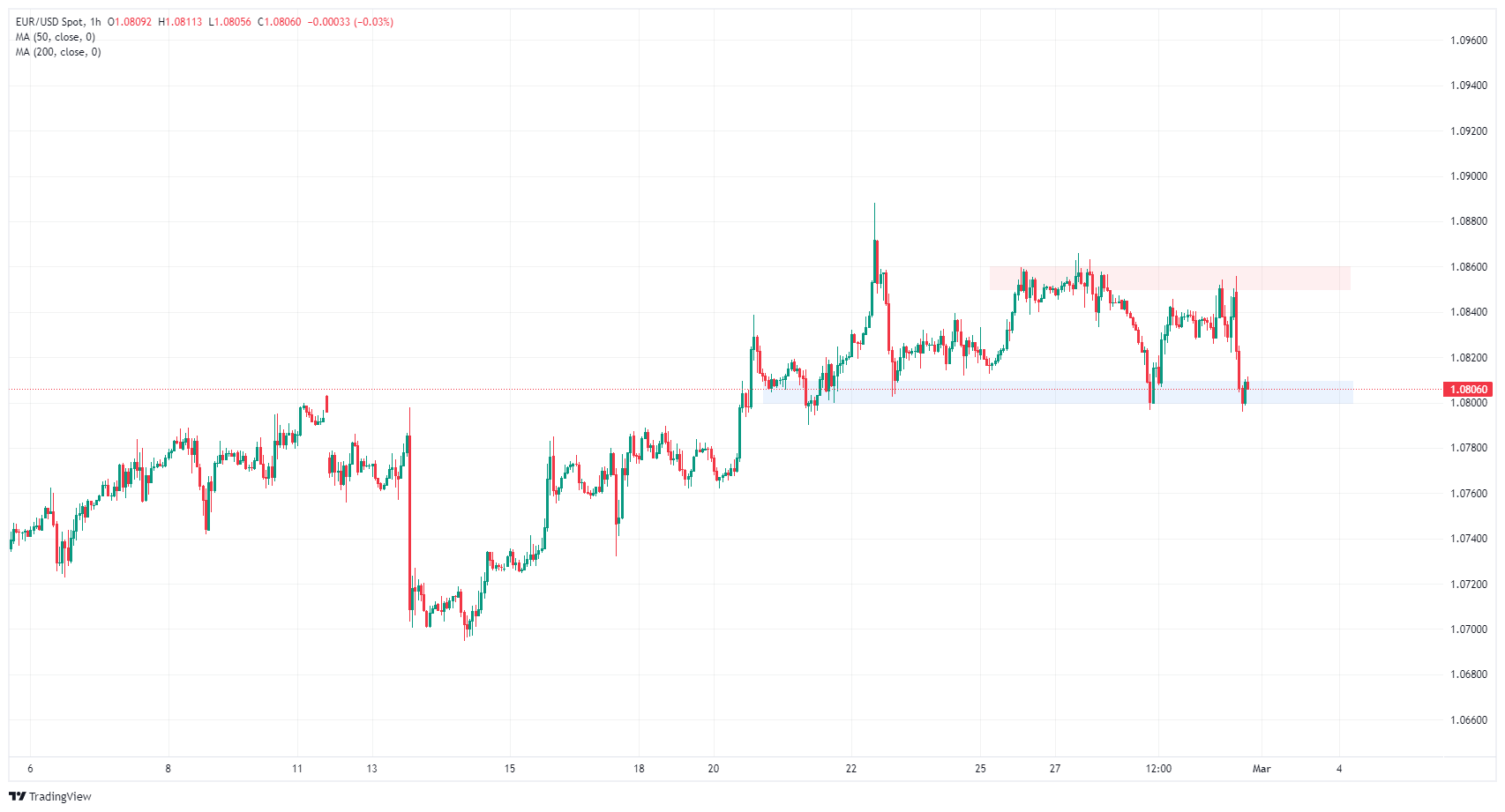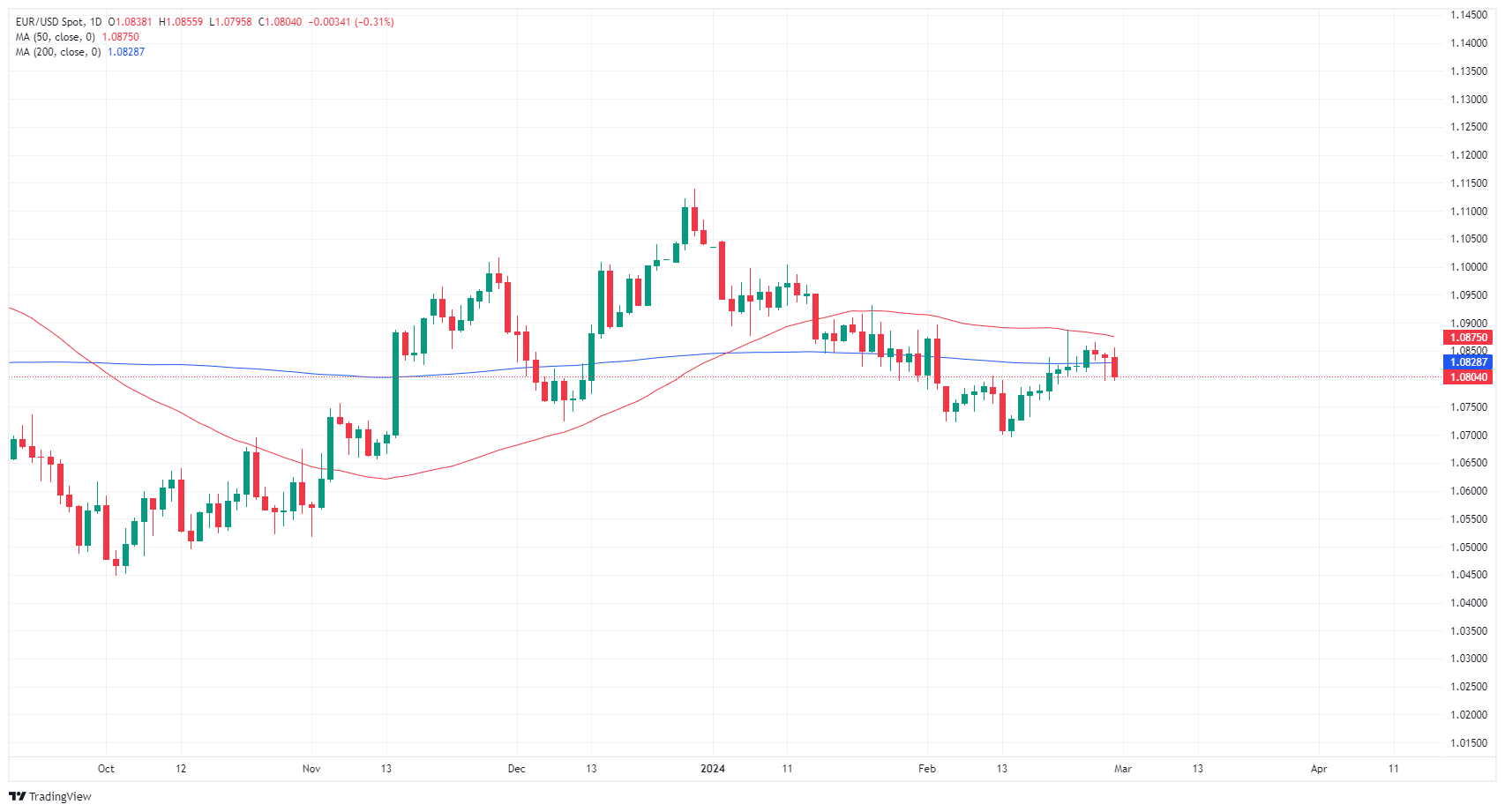- Analytics
- News and Tools
- Market News
- EUR/USD falls into familiar territory on Thursday after US PCE inflation boosts Greenback
EUR/USD falls into familiar territory on Thursday after US PCE inflation boosts Greenback
- EUR/USD knocked back into 1.0800 again on Thursday.
- German Retail Sales, CPI showed economic weakness.
- US PCE inflation came in as expected, lower than the prior month
EUR/USD drifted back into the 1.0800 handle once again on Thursday after weak-kneed German Retail Sales and Consumer Price Index (CPI) inflation came in mixed but missed the mark overall. The US Personal Consumption Expenditure Price Index (PCE) printed at median market forecasts, but investor confidence still wavered as US inflation remains too high for the Federal Reserve (Fed) to rush into rate cuts.
Friday will bring pan-European Harmonized Index of Consumer Prices (HICP) inflation for February, and February’s US ISM Manufacturing will round out the trading week. European HICP inflation is forecast to tick lower for the year ended February, and the US ISM Manufacturing PMI is expected to recover slightly but remain in contraction territory.
Daily digest market movers: EUR/USD backslides on US PCE inflation non-starter
- German YoY Retail Sales in January came in at -1.4%, falling less than the forecast of -1.5% but still a slight recovery from the previous -1.7%.
- MoM German Retail Sales missed the mark, printing at -0.4% versus the forecast of 0.5%. The previous month saw a -1.6% print.
- Germany’s YoY CPI for February saw 2.5% versus the forecast of 2.6%, down from the previous 2.9%.
- US Core PCE for the year through January printed at market expectations, coming in at the forecast of 2.4% versus the previous 2.6%.
- The Fed’s favored inflation indicator eased back in-line with model forecasts, but the figure still remains above the US central bank’s inflation target, eating away at investor hopes for a near-term Fed rate cut.
- According to the CME FedWatch Tool, money markets see nearly 80% chance of no rate cut in May, and a 35% chance of another rate hold in June.
Euro price today
The table below shows the percentage change of Euro (EUR) against listed major currencies today. Euro was the weakest against the Japanese Yen.
| USD | EUR | GBP | CAD | AUD | JPY | NZD | CHF | |
| USD | 0.33% | 0.36% | 0.02% | 0.00% | -0.44% | 0.21% | 0.63% | |
| EUR | -0.35% | 0.02% | -0.32% | -0.33% | -0.78% | -0.11% | 0.30% | |
| GBP | -0.37% | -0.03% | -0.35% | -0.37% | -0.82% | -0.16% | 0.27% | |
| CAD | -0.02% | 0.33% | 0.34% | -0.02% | -0.47% | 0.20% | 0.62% | |
| AUD | -0.01% | 0.33% | 0.36% | 0.02% | -0.46% | 0.21% | 0.63% | |
| JPY | 0.44% | 0.79% | 0.81% | 0.45% | 0.44% | 0.68% | 1.09% | |
| NZD | -0.21% | 0.13% | 0.16% | -0.19% | -0.20% | -0.67% | 0.45% | |
| CHF | -0.63% | -0.29% | -0.27% | -0.61% | -0.64% | -1.10% | -0.41% |
The heat map shows percentage changes of major currencies against each other. The base currency is picked from the left column, while the quote currency is picked from the top row. For example, if you pick the Euro from the left column and move along the horizontal line to the Japanese Yen, the percentage change displayed in the box will represent EUR (base)/JPY (quote).
Technical analysis: EUR/USD drops back to familiar technical support at 1.0800 on Thursday
EUR/USD slid back into the 1.0800 handle on Thursday, declining a little over half a percent top-to-bottom from the day’s high at 1.0856. The pair has struggled to find topside momentum since climbing over 1.0800 on February 20.
EUR/USD remains trapped between a supply zone near 1.0860 and a heavy demand zone above 1.0800. Near-term technicals are leaning into a bullish recovery if selling pressure fails to crack 1.0800.
EUR/USD remains mired on the 200-day Simple Moving Average (SMA) at 1.0828, and Thursday’s decline sets the pair up for a steeper downside rejection. The pair has struggled at the key long-term moving average since rising from the last swing low into the 1.0700 handle.
EUR/USD hourly chart
EUR/USD daily chart
Euro FAQs
What is the Euro?
The Euro is the currency for the 20 European Union countries that belong to the Eurozone. It is the second most heavily traded currency in the world behind the US Dollar. In 2022, it accounted for 31% of all foreign exchange transactions, with an average daily turnover of over $2.2 trillion a day.
EUR/USD is the most heavily traded currency pair in the world, accounting for an estimated 30% off all transactions, followed by EUR/JPY (4%), EUR/GBP (3%) and EUR/AUD (2%).
What is the ECB and how does it impact the Euro?
The European Central Bank (ECB) in Frankfurt, Germany, is the reserve bank for the Eurozone. The ECB sets interest rates and manages monetary policy.
The ECB’s primary mandate is to maintain price stability, which means either controlling inflation or stimulating growth. Its primary tool is the raising or lowering of interest rates. Relatively high interest rates – or the expectation of higher rates – will usually benefit the Euro and vice versa.
The ECB Governing Council makes monetary policy decisions at meetings held eight times a year. Decisions are made by heads of the Eurozone national banks and six permanent members, including the President of the ECB, Christine Lagarde.
How does inflation data impact the value of the Euro?
Eurozone inflation data, measured by the Harmonized Index of Consumer Prices (HICP), is an important econometric for the Euro. If inflation rises more than expected, especially if above the ECB’s 2% target, it obliges the ECB to raise interest rates to bring it back under control.
Relatively high interest rates compared to its counterparts will usually benefit the Euro, as it makes the region more attractive as a place for global investors to park their money.
How does economic data influence the value of the Euro?
Data releases gauge the health of the economy and can impact on the Euro. Indicators such as GDP, Manufacturing and Services PMIs, employment, and consumer sentiment surveys can all influence the direction of the single currency.
A strong economy is good for the Euro. Not only does it attract more foreign investment but it may encourage the ECB to put up interest rates, which will directly strengthen the Euro. Otherwise, if economic data is weak, the Euro is likely to fall.
Economic data for the four largest economies in the euro area (Germany, France, Italy and Spain) are especially significant, as they account for 75% of the Eurozone’s economy.
How does the Trade Balance impact the Euro?
Another significant data release for the Euro is the Trade Balance. This indicator measures the difference between what a country earns from its exports and what it spends on imports over a given period.
If a country produces highly sought after exports then its currency will gain in value purely from the extra demand created from foreign buyers seeking to purchase these goods. Therefore, a positive net Trade Balance strengthens a currency and vice versa for a negative balance.
© 2000-2024. All rights reserved.
This site is managed by Teletrade D.J. LLC 2351 LLC 2022 (Euro House, Richmond Hill Road, Kingstown, VC0100, St. Vincent and the Grenadines).
The information on this website is for informational purposes only and does not constitute any investment advice.
The company does not serve or provide services to customers who are residents of the US, Canada, Iran, The Democratic People's Republic of Korea, Yemen and FATF blacklisted countries.
Making transactions on financial markets with marginal financial instruments opens up wide possibilities and allows investors who are willing to take risks to earn high profits, carrying a potentially high risk of losses at the same time. Therefore you should responsibly approach the issue of choosing the appropriate investment strategy, taking the available resources into account, before starting trading.
Use of the information: full or partial use of materials from this website must always be referenced to TeleTrade as the source of information. Use of the materials on the Internet must be accompanied by a hyperlink to teletrade.org. Automatic import of materials and information from this website is prohibited.
Please contact our PR department if you have any questions or need assistance at pr@teletrade.global.















